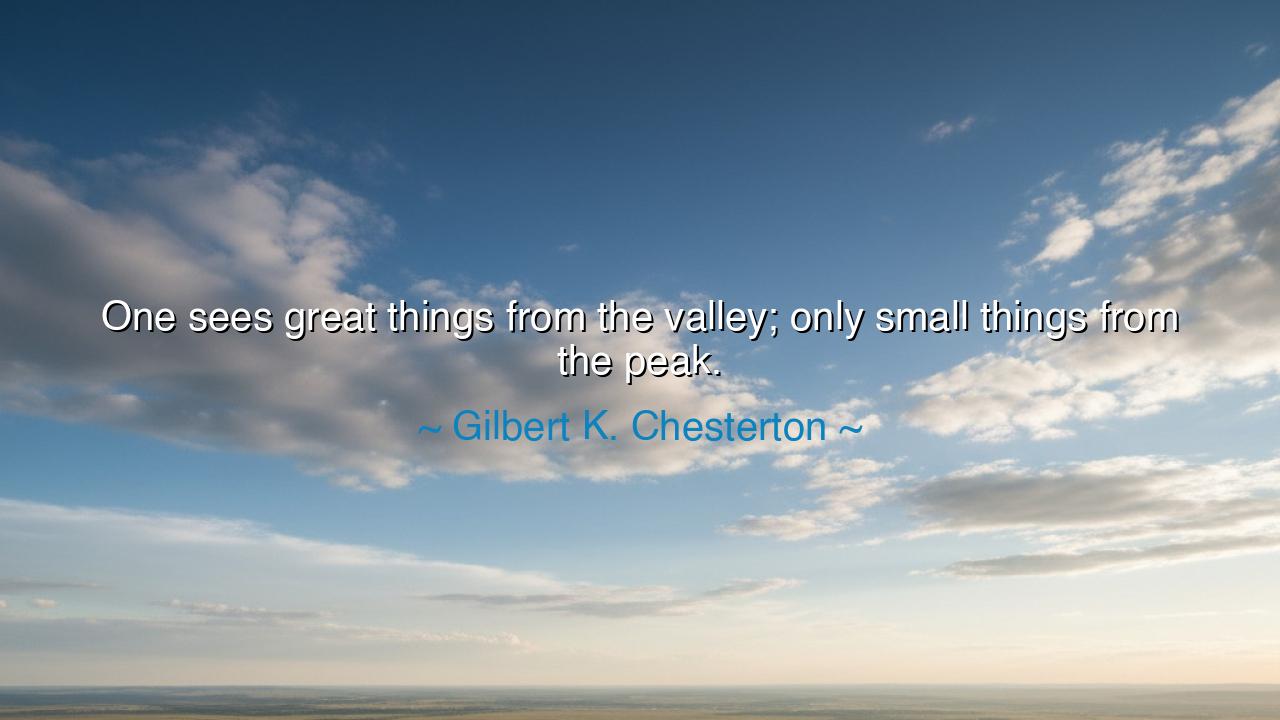
One sees great things from the valley; only small things from the






“One sees great things from the valley; only small things from the peak.” — Gilbert K. Chesterton.
Thus spoke Gilbert Keith Chesterton, the paradoxical sage of England, whose pen danced between wit and wonder, between the laughter of man and the mystery of God. In this line — brief, shining, and sharp as a sword — he reveals a truth that defies the vanity of the world: that greatness is not always found in height, but in humility. For the valley, though lowly, gives us the vision to behold what is vast, while the peak, though exalted, narrows our sight until the infinite seems small.
The origin of this thought lies in Chesterton’s lifelong defense of paradox — the art of turning the world upside down to see it rightly. He saw that man, in his hunger for greatness, often climbs too high and forgets to see. The mountaintop, symbol of triumph, can become a prison of pride. From it, all else seems beneath; the world grows small, and the self grows large. But in the valley, where shadows dwell and rivers flow, perspective returns. There, surrounded by what towers above, the soul feels the immensity of creation — and in its humility, it sees great things once more.
To the ancients, the valley was not a place of defeat, but of renewal. The farmer, not the king, knew the secret of growth — that life springs from the low ground where water gathers. The prophets too descended to the valleys to hear the divine voice, for the mountains may touch the sky, but the valley holds the echo of heaven. In this way, Chesterton’s words carry a wisdom older than any empire: that perspective is born from humility, and that the eye must sometimes bow before it can truly see.
Consider the story of Mahatma Gandhi, who, though small and unarmed, saw farther than the mighty rulers of his age. While empires gazed down from their peaks of power, blind to the suffering below, Gandhi walked among the people — the poor, the broken, the forgotten. It was there, in the valley of human struggle, that he perceived the true greatness of compassion, truth, and moral strength. And so, his vision, born from humility, reshaped nations, while the empires that towered over him crumbled into dust.
Chesterton’s words remind us that to see great things, one must learn to dwell among them — to stand close enough to their roots to understand their depth. From the peak, the mountain looks small; from the valley, it looms magnificent. So it is with life, with love, with faith. When we are high with success, we see little but ourselves; when we descend into hardship, sorrow, or service, we discover the boundless landscape of meaning. The valley teaches us empathy; the peak tempts us with isolation.
This is not to condemn the summit, but to warn the climber: do not mistake height for clarity. The higher we rise in pride, the more we risk blindness. But when we return to the ground — to gratitude, to humility, to the shared struggles of others — the world grows great again. The wise do not remain on the mountain forever; they descend, as Moses did, carrying the light of revelation into the lowlands of men.
So let this be the lesson for all who seek wisdom: Do not fear the valley. It is there that your sight will be restored. When life humbles you, do not call it failure; call it vision. When you find yourself low, look up — for only then can you see how high the heavens truly are. Walk among the ordinary, for there you will glimpse the extraordinary. Serve, listen, and love — and the world will unfold before you in its true vastness.
For as Chesterton teaches, the soul that clings to the peak will see only the smallness of the world, but the heart that dwells in the valley — humble, grateful, and open — will behold the greatness of all things. So descend, seeker of truth, and see anew. For the valley, not the summit, is where the world reveals its glory.






AAdministratorAdministrator
Welcome, honored guests. Please leave a comment, we will respond soon